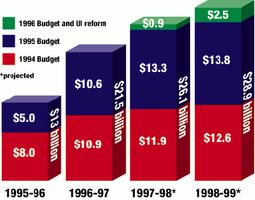
Public Expenditure
Public expenditure refers to government spending. From an average of 20% of Gross Domestic Product (GDP) from 1947 to 1951, total government expenditures rose to a peak of 49% of GDP in 1992, before declining slightly to 45% in 1995. Over the 1947-95 period as a whole, total government expenditures as measured in the national accounts (a comprehensive series of statistics) rose 114% faster than GDP.For many economic purposes, however, the total size of government expenditures is less significant than the components of these expenditures. The distinction between transfer expenditures, which shift private income from one person to another, and exhaustive expenditures, which use goods and services for government activities proper, is particularly important. Since 1970, 36% of the increase in public expenditures is attributable to transfers and only 41% to expenditures on goods and services. (The remainder is interest on the PUBLIC DEBT.) By 1995, transfer expenditures including interest accounted for over 57% of all government spending.
The relative prices of the goods and services that government purchases must also be taken into account. In real terms, the relative expansion of government spending as a proportion of GDP from 1947 to 1995 was 44%, not 114%. Since 1970 the proportion of real goods and services produced in the economy that is used by the government sector in the course of its activities has actually declined by about 17%. In contrast, the share of transfer payments in real GDP roughly doubled during this period. This is largely because of a significant liberalization of child benefits and unemployment insurance.
More than 50% of the postwar increase in government expenditures is accounted for by expenditures on health, education and welfare. Since 1970 government expenditures on education actually declined in relation to GDP. In the 1960s public health spending rose substantially, largely in substitution for private expenditures. Total health expenditures in relation to GDP changed relatively little. Since 1970, only expenditures on social welfare, mainly in the form of large cash transfer programs, have continued to expand significantly.
Provincial and local governments are responsible for almost all educational and health expenditures. Over the postwar period the growth in federal government expenditures accounted for only 5% of the total growth in government share in real GDP, compared to 89% for the provincial-local sector (including hospitals). The remaining 6% is accounted for by the CANADA PENSION PLAN and the separate, but closely related, QUÉBEC PENSION PLAN. In 1995 the federal government was responsible for only 38% of total government expenditures (excluding intergovernmental transfers) - a proportion that has changed little since the mid-1960s.
The decline in federal defence spending freed resources that financed the expanding provincial and local health and education sectors. At the same time, programs such as OLD-AGE PENSION, FAMILY ALLOWANCES and UNEMPLOYMENT INSURANCE were financed by a considerable increase in taxes. Yet these programs appear to have redistributed income among Canadians only slightly because so many of the taxes were paid by the same broad groups that received the transfers.
See also PUBLIC FINANCE.

 Share on Facebook
Share on Facebook Share on X
Share on X Share by Email
Share by Email Share on Google Classroom
Share on Google Classroom
